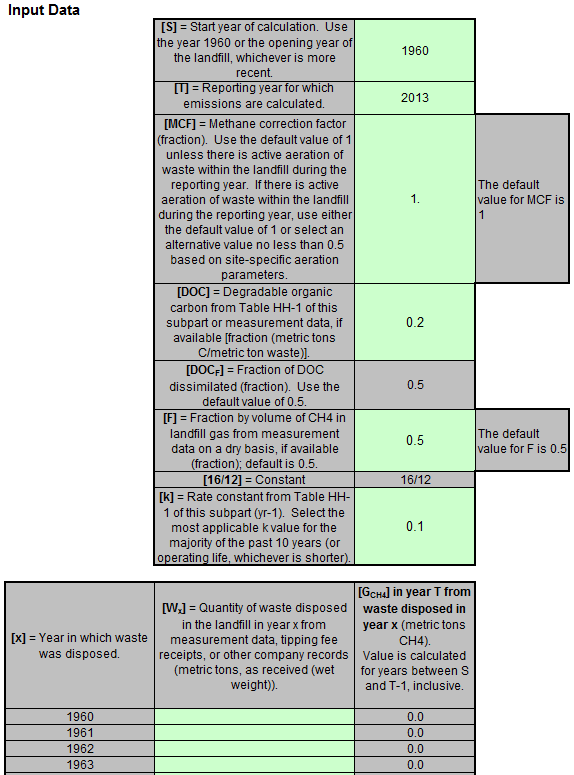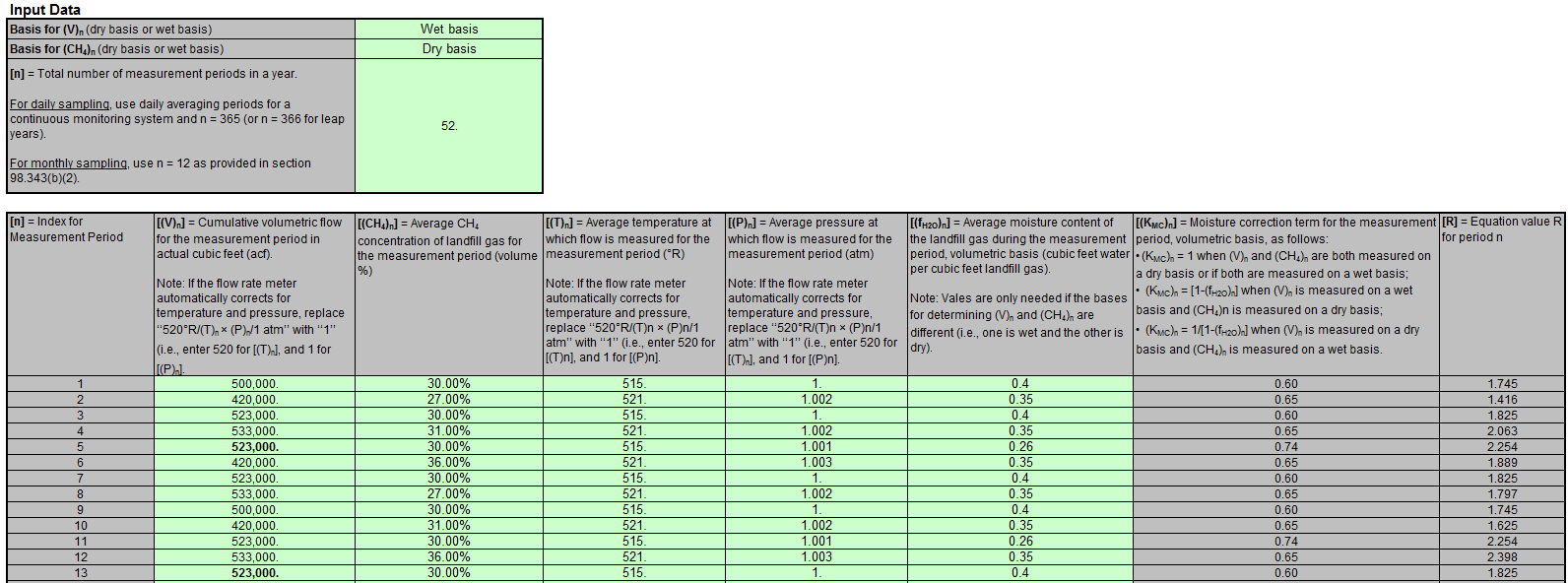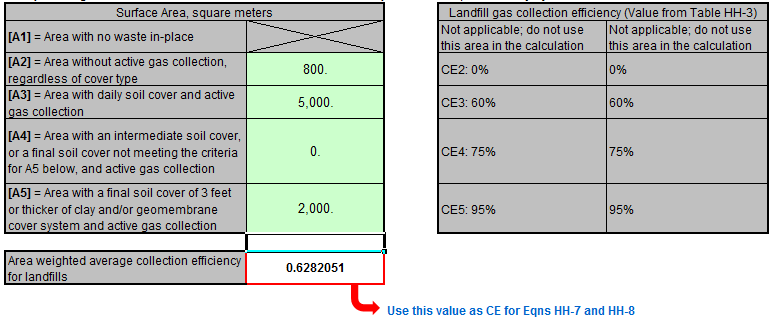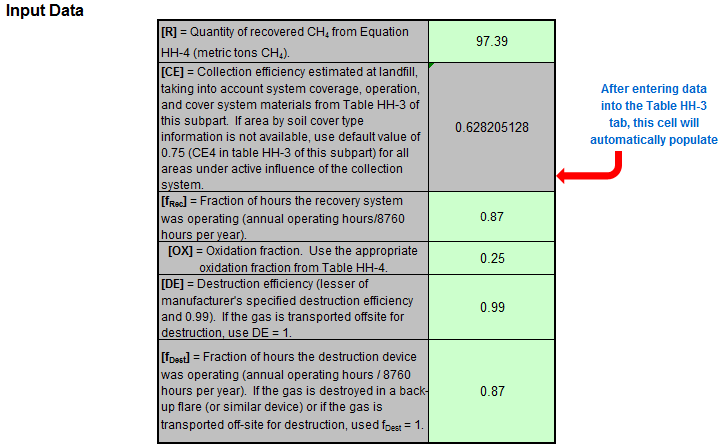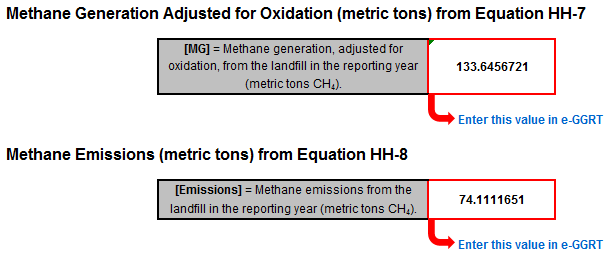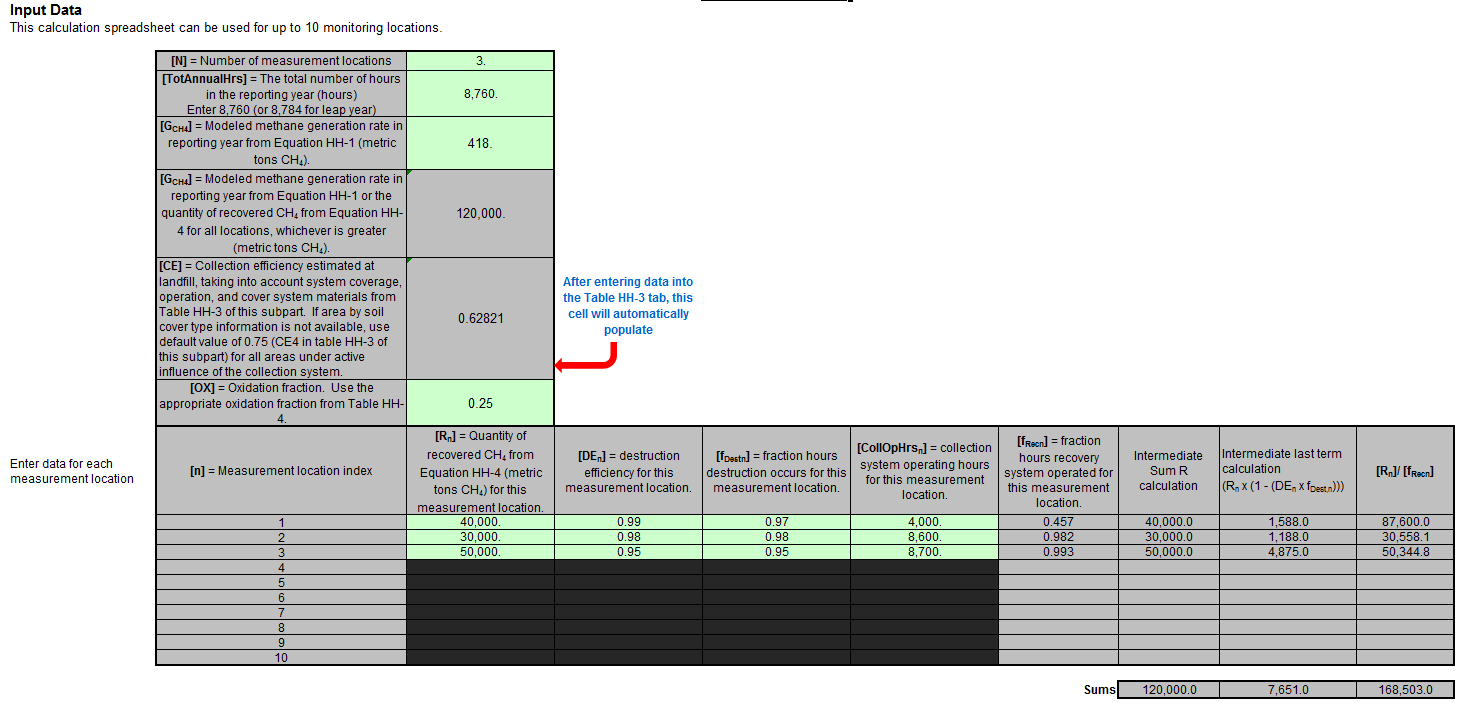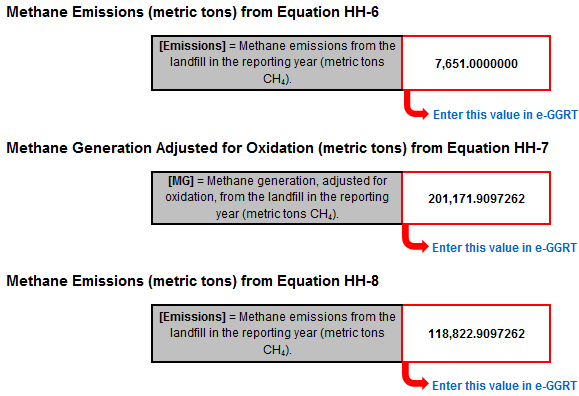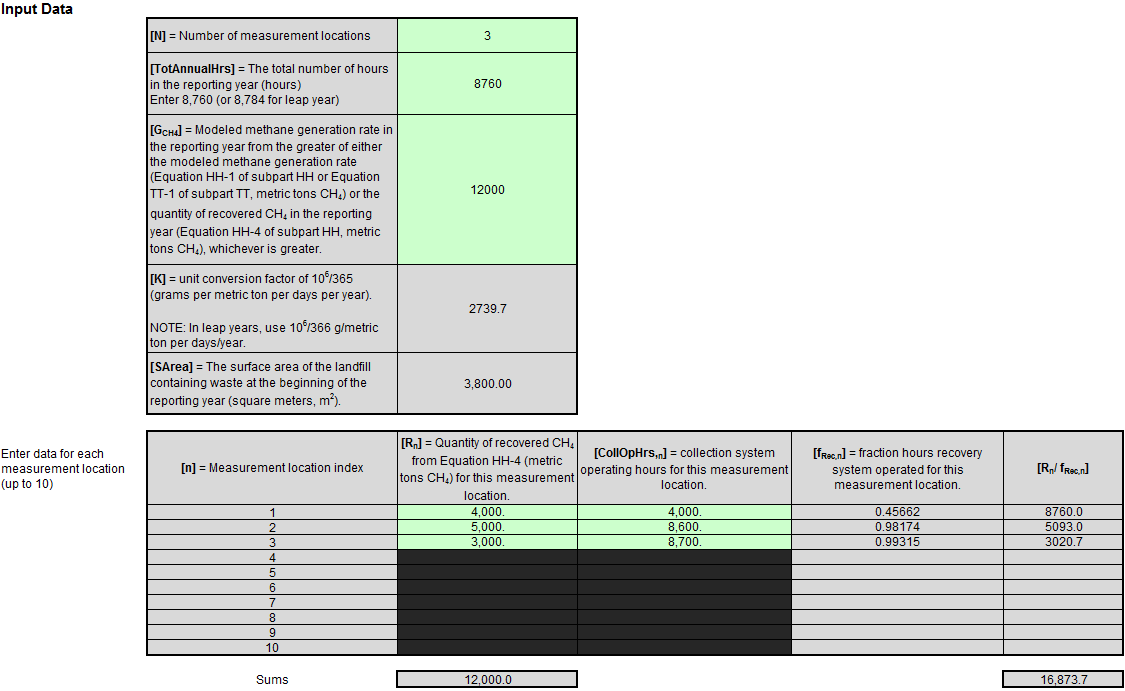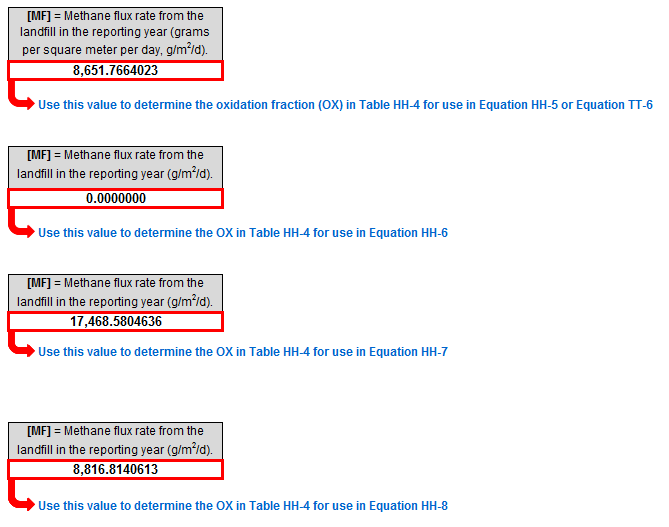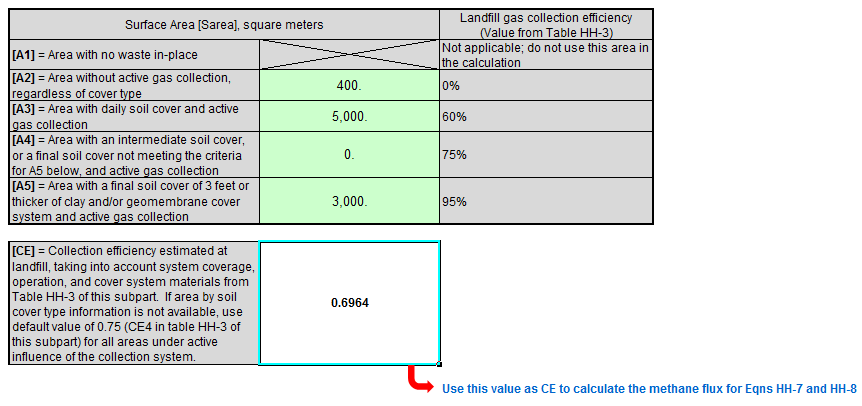| Anchor | ||||
|---|---|---|---|---|
|
| Excerpt Include | ||||||
|---|---|---|---|---|---|---|
|
Overview
This help page provides guidance for working with the supplemental Subpart HH calculation spreadsheets. The guidance provides step-by-step instructions for the following tasks:
- Selecting the Appropriate Calculation Spreadsheet
- General Information on Using a Calculation Spreadsheet
- Using the Equation HH-1 Calculation Spreadsheet
- Using the Equation HH-4 Calculation Spreadsheet
- Using the Equation HH-5 Calculation Spreadsheet
- Using the Equations HH-6, HH-7,and HH-8 Calculation Spreadsheet
- Using the Methane Flux Calculation Spreadsheet
Specific information on each of the calculation spreadsheets is provided below:
Calculation Spreadsheet | Calculation | Spreadsheet Applicability | Instructions |
|---|---|---|---|
Modeled methane generation rate in reporting year | All landfills | ||
Annual quantity of recovered CH4 | Landfills with landfill gas collection systems | ||
Methane generation, adjusted for oxidation, from the landfill in the reporting year | All landfills | ||
Methane generation, adjusted for oxidation, from the landfill in the reporting year (by Equation HH-7) and Methane emissions from the landfill in the reporting year by two different ways (by Equation HH-6 and by Equation HH-8) | Landfills with landfill gas collection systems | ||
| HH Methane Flux Calculation Spreadsheet.xlsx | The methane oxidation factor is based on the methane flux rate which can be calculated using the Methane Flux Calculation spreadsheet | Landfills with landfill gas collection systems | Methane Flux Calculation Help |
Selecting the Appropriate Calculation Spreadsheet
For all landfills subject to the reporting requirements of Subpart HH, calculate annual modeled CH4 generation using the Equation HH-1 Calculation Spreadsheet and according to the requirements in 98.343(a)(1) through 98.343(a)(3). Equation HH-1 is provided below.
(Equation HH-1) |
|---|
For landfills that do not collect and control landfill gas, adjust the modeled annual CH4 generation (result of Equation HH-1) to account for soil oxidation (CH4 that is converted to CO2 as it passes through the landfill cover before being emitted) using the Equation HH-5 Calculation Spreadsheet. The resulting value represents both CH4 generation (adjusted for oxidation) and CH4 emissions for landfills that do not collect and destroy landfill gas.
(Equation HH-5) |
|---|
For landfills that collect and control landfill gas, calculate the annual quantity of CH4 recovered and destroyed using Equation HH-4 and the Equation HH-4 Calculation Spreadsheet which is based on continuous monitoring of gas flow rate and continuous or monthly monitoring of CH4 concentration, temperature, pressure, and moisture content of the collected gas prior to the destruction device. Equation HH-4 is provided below.
(Equation HH-4) |
|---|
Facilities that collect and control landfill gas must then calculate CH4 generation (adjusted for oxidation) and CH4 emissions in two ways each and report all four results. CH4 generation (adjusted for oxidation) and CH4 emissions should be calculated by:
- First using Equation HH-5 and the Equation HH-5 Calculation Spreadsheet to determine CH4 generation (adjusted for oxidation).
- Then using Equation HH-6 and the Equation HH-6, HH-7, HH-8 Calculation Spreadsheet which subtracts the measured amount of CH4 recovered from the modeled annual CH4 generation (with adjustments for soil oxidation and destruction efficiency of the destruction device).
- Finally, using Equations HH-7 and HH-8 and the Equation HH-6, HH-7, HH-8 Calculation Spreadsheet which applies a gas collection efficiency to the measured amount of recovered CH4 and accounts for CH4 that is emitted through the landfill surface (adjusted for soil oxidation). Default collection efficiencies that take into account collection system coverage and landfill cover materials are specified in Table HH-3 found in a separate tab within the Equation HH-6, HH-7, HH-8 Calculation Spreadsheet. If a single measurement location is used to determine gas recovery for multiple destruction devices, the Equation HH-6, HH-7, HH-8 Calculation Spreadsheet also provides equations for computing destruction efficiency and fraction of hours destruction devices were operating in the “MultiDD_per_MeasLocation” tab.
If a single measurement location is used to determine gas recovery for one or more destruction devices, use the “Equation HH-6” and “Equation HH-7” tabs. When multiple destruction devices are associated with a single measurement location, use the “MultiDD_per_MeasLocation” tab to compute the destruction efficiency (DE) and fraction of hours the destruction devices were operating (fDest). The values for DE and fDest as computed on the “MultiDD_per_MeasLocation” tab should then be used in the “Equation HH-6” and “Equation HH-7” tabs.
- If, multiple gas measurement locations are associated with one or more destruction devices, use the “Equation HH-6,HH-7,HH-8_Multi” tab in the Equation HH-6, HH-7, HH-8 Calculation Spreadsheet. Equations HH-6, HH-7, and HH-8 for multiple measurement locations are provided below.
Equation HH-5 is provided above. Equations HH-6, HH-7 and HH-8 provided below can be used when one measurement location is associated with one or more destruction devices.
(Equation HH-6) | |
|---|---|
(Equation HH-7) | |
(Equation HH-8) |
The Equation HH-6, HH-7, HH-8 Calculation Spreadsheet also provides alternate equations to implement Equations HH-6, HH-7, and HH-8 when multiple gas recovery measurement locations are used (in tab “Equation HH-6,HH-7,HH-8_Multi”). These alternate forms of Equations HH-6, HH-7, and HH-8 are provided below.
(Equation HH-6) | |
|---|---|
(Equation HH-7) | |
(Equation HH-8) |
General Informatoin on Using a Calculation Spreadsheet
The guidance provided in this section applies to each of the calculation spreadsheets for Subpart HH. Additional guidance is provided for each individual calculation spreadsheet in the sections below.
Color Coding
The calculation spreadsheets contain green input cells, gray informational cells and red-bordered results cells. Users should use green input cells to enter all data specific to their facility, unit, or process. As you progress through a reporting form, you may notice some green input cells changing to black deactivated cells. Black deactivated cells are not applicable to the user based on previous data entries in the form. Users should not enter data into these cells. Gray informational cells contain parameter names, column and row headings, equation constants and subtotals. Calculation results are displayed in red-bordered results cells. Values displayed in red-bordered cells should be entered into another cell within the same calculation spreadsheet or in another calculation spreadsheet as directed by spreadsheet instructions. Values displayed in red-bordered cells with white fill should be entered directly into e-GGRT. All cells that are not green input cells are locked and cannot be modified.
Green input cell (data entry) | |
Black deactivated cell (not applicable, no data required) | |
Gray informational cells (locked) | |
Red-bordered/yellow fill results cells (enter into another spreadsheet) | |
Red-bordered/white fill results cells (enter into e-GGRT) |
| Include Page | ||||
|---|---|---|---|---|
|
Using the Equation HH-1 Calculation Spreadsheet
Calculate the annual modeled CH4 generation using Equation HH-1 and the Equation HH-1 Calculation Spreadsheet for a landfill. Use the appropriate parameter values for k, DOC, MCF, DOCF, and F shown in Table HH-1 within the calculation spreadsheet. For years when waste composition data are not available, use either the bulk waste or the modified bulk MSW parameter values for k and DOC in Table HH-1 for the total quantity of waste disposed in those years.
If, prior to 2010, the quantity of waste disposed each year (Wx) is estimated using Equation HH-2 or HH-3, use the Equation HH-2, HH-3 Calculation Spreadsheet first and enter the resulting Wx values in the appropriate column in the Equation HH-1 Calculation Spreadsheet.
Equation HH-1 is provided below:
(Equation HH-1) |
|---|
Begin by entering the facility name, your name, the unit name or identifier, the reporting period, and any additional comments in the green input cells of the general information table located immediately below the equation in the calculation spreadsheet. This is for your records.
Next, enter the requested information in the green input cells in the Input Data table.
The calculation spreadsheet will calculate the modeled CH4 generation from the landfill in the reporting year. Note that even though a value for Wx may be entered in the reporting year (T), a value for GCH4 will appear as 0 metric tons CH4. This is result from the term T-1 in Equation HH-1, which has a built-in time delay to account for the transitional period from an aerobic environment to an anaerobic environment within the landfill.
The calculated value will be displayed in a red-bordered cell at the bottom of the spreadsheet. This value should be entered in the Equation HH-5 Calculation Spreadsheet for this landfill.
Using the Equation HH-4 Calculation Spreadsheet
For landfills that collect and control landfill gas, calculate the annual quantity of CH4 recovered and destroyed using Equation HH-4 and the Equation HH-4 Calculation Spreadsheet. If you do not continuously monitor according to paragraph 98.343(b)(1), you must determine the volumetric flow rate, CH4 concentration, temperature, pressure, and moisture content of the landfill gas that is collected and routed to a destruction device (before any treatment equipment) according to the requirements in paragraphs 98.343(b)(2)(i) through 98.343(b)(2)(iii). Equation HH-4 is provided below. If there are multiple measurement locations at your facility, copies of this worksheet can be made for each measurement location. The total amount of CH4 recovered and destroyed across all measurement locations at your facility should be used in Equations HH-6, HH-7, and HH-8.
(Equation HH-4) |
|---|
Next, enter the requested information in the green input cells in the Input Data table. Based on your entries in the first Input Data table, required cells will be activated to green input cells in the second Input Data table.
| Composition Setup |
|---|
| Toggle Cloak | ||
|---|---|---|
|
| Cloak | ||||||
|---|---|---|---|---|---|---|
| ||||||
The calculation spreadsheet will calculate the annual quantity of CH4 recovered from the landfill. The calculated value will be displayed in a red-bordered cell at the bottom of the spreadsheet. This value should be entered in the Equation HH-6, HH-7, HH-8 Calculation Spreadsheet for this landfill.
Methane Recovery (metric tons) for Equation HH-4
Using the Equation HH-5 Calculation Spreadsheet
Calculate the annual CH4 generation (adjusted for oxidation) using Equation HH-5 and the Equation HH-5 Calculation Spreadsheet for a landfill. For landfills that do not have landfill gas collection systems, the annual CH4 emissions are equal to the CH4 generation (MG) calculated using Equation HH-5 (calculate CH4 emissions using the Equation HH-6 Calculation Spreadsheet for landfills with landfill gas collection systems). Equation HH-5 is provided below.
(Equation HH-5) |
|---|
Begin by entering the facility name, your name, the unit name or identifier, the reporting period, and any additional comments in the green input cells of the general information table located immediately below the equation in the calculation spreadsheet. This is for your records.
Next, enter the requested information in the green input cells in the Input Data table, including the result of Equation HH-1 as calculated using the Equation HH-1 Calculation Spreadsheet. Select the value for the oxidation fraction from Table HH-4 from the drop-down list. Refer to the HH Methane Flux Calculation Spreadsheet to compute the methane flux if desired.
The calculation spreadsheet will calculate the CH4 generation (adjusted for oxidation) from the landfill in the reporting year. For landfills that do not have landfill gas collection systems, the annual CH4 emissions are equal to the annual CH4 generation (adjusted for oxidation). The calculated value will be displayed in a red-bordered cell at the bottom of the spreadsheet. This value should be entered into e-GGRT for this landfill.
NOTE: Facilities that collect and control landfill gas must calculate CH4 generation (adjusted for oxidation) and CH4 emissions in two ways each and report all four results. Calculate CH4 generation (adjusted for oxidation) using both Equation HH-5 (above) and Equation HH-7 (below). Calculate CH4 emissions using both Equation HH-6 and Equation HH-8 (both are below). Calculation spreadsheets are provided for each of these equations. Enter all resulting values into e-GGRT.
Using the Equations HH-6, HH-7, and HH-8 Calculation Spreadsheet
Calculate the annual CH4 emissions from the modeled CH4 generation and measured CH4 recovery using Equation HH-6 and the Equation HH-6, HH-7, HH-8 Calculation Spreadsheet for a landfill. This tab applies to landfills with landfill gas collection systems with a single gas recovery measurement location associated with one or more destruction devices. If multiple gas recovery measurement locations are used, see “Using the Equation HH-6, HH-7, HH-8_Multi Tab in the Equation HH-6, HH-7, HH-8 Calculation Spreadsheet.” Equation HH-6 is provided below
(Equation HH-6) |
|---|
Begin by entering the facility name, your name, the unit name or identifier, the reporting period, and any additional comments in the green input cells of the general information table located immediately below the equation in the calculation spreadsheet. This is for your records.
Next, enter the requested information in the green input cells in the Input Data table, including the result of Equation HH-1 as calculated using the Equation HH-1 Calculation Spreadsheet and the result of Equation HH-4 as calculated using the Equation HH-4 Calculation Spreadsheet. Note that if the result of Equation HH-4 is greater than the result of Equation HH-1, the value entered in the green input cell for GCH4 in the Equation HH-6 spreadsheet should equal the quantity of recovered CH4 from Equation HH-4. This is done to avoid generating a negative result for Equation HH-6
Select the value for the oxidation fraction from Table HH-4 from the drop-down list. Refer to the HH Methane Flux Calculation Spreadsheet to compute the methane flux if desired.
If gas recovery measurements are made at a single location for multiple destruction devices, use the “MultiDD_per_MeasLocation” tab in the Equation HH-6, HH-7, HH-8 Calculation Spreadsheet to determine appropriate values for the destruction efficiency DE and the fraction of hours the destruction device was operating fDest. See section below for further explanation on using the “MultiDD_per_MeasLocation” tab.
The calculation spreadsheet will calculate the CH4 emissions from the landfill in the reporting year. The calculated value will be displayed in a red-bordered cell at the bottom of the spreadsheet. This value should be entered into e-GGRT for this landfill.
Calculate CH4 generation and CH4 emissions from a landfill using measured CH4 recovery and estimated gas collection efficiency. These calculations employ Equations HH-7 and HH-8 and the Equation HH-6, HH-7, HH-8 Calculation Spreadsheet. This tab applies to landfills with landfill gas collection systems with a single gas recovery measurement location associated with one or more destruction devices. If multiple gas recovery measurement locations are used, see “Using the Equation HH-6, HH-7, HH-8_Multi Tab in the Equation HH-6, HH-7, HH-8 Calculation Spreadsheet.” Equations HH-7 and HH-8 are provided below.
(Equation HH-7) | |
|---|---|
(Equation HH-8) |
Begin by entering the facility name, your name, the unit name or identifier, the reporting period, and any additional comments in the green input cells of the general information table located immediately below the equation in the calculation spreadsheet. This is for your records.
Then, enter the requested information in the green input cells in the Input Data for Calculating Weighted Average for CE table to estimate the collection efficiency at the landfill, taking into account system coverage, operation, and cover system materials from Table HH-3. Table HH-3 may be found in a separate tab within the Equation HH-7, HH-8 Calculation Spreadsheet. The calculated area-weighted collection efficiency will be displayed in a red-bordered cell below the table. This value should be entered into the Input Data table below.
If area by soil cover type information is not available, use a default value of 0.75 for all areas under active influence of the collection system. Please note that landfills with Area Type A2 as defined in Table HH-3, i.e., “Area without active gas collection, regardless of cover type,” cannot simply use the default of 0.75 for CE in Equations HH-7 and HH-8. The 0.75 is not an alternative to the area-weighted methodology for all landfills. The 0.75 alternative can only be used for those that do not know the relative areas of daily, intermediate, and final soil covers (as described in Table HH-3). The 0.75 value also does not apply to the entire landfill; it only applies to that portion of the landfill under active influence of the gas collection system. If there are areas of the landfill that are not under active influence of the gas collection system, you must report that area under Area Type A2 and then use the resulting area-weighted average CE in Equations HH-7 and HH-8, even if you use the default of 0.75 for all areas under active gas collection.
Next, enter the requested information in the green input cells in the Input Data table, including the result of Equation HH-4 as calculated using the Equation HH-4 Calculation Spreadsheet. Select the value for the oxidation fraction from Table HH-4 from the drop-down list. Refer to the HH Methane Flux Calculation Spreadsheet to compute the methane flux if desired.
If gas recovery measurements are made at a single location for multiple destruction devices, use the “MultiDD_per_MeasLocation” tab in the Equation HH-6, HH-7, HH-8 Calculation Spreadsheet to determine appropriate values for the destruction efficiency DE and the fraction of hours the destruction device was operating fDest.
The calculation spreadsheet will calculate the CH4 generation and CH4 emissions from this landfill in the reporting year. The calculated values will be displayed in red-bordered cells at the bottom of the spreadsheet. These values should be entered into e-GGRT for this landfill.
| h3.anchor |
|---|
Using the Equation HH-6, HH-7, HH-8 Multi Tab in the Equation HH-6, HH-7, HH-8 Calculation Spreadsheet |
The Equation HH-6, HH-7, HH-8_Multi tab in the Equation HH-6, HH-7, HH-8 Calculation Spreadsheet provides the appropriate application of Equations HH-6, HH-7, and HH-8 when multiple gas recovery measurement locations are used at a single facility. Equations HH-6, HH-7 and HH-8 suitable for facilities with multiple landfill gas recovery measurement locations are provided below.
(Equation HH-6) | |
|---|---|
(Equation HH-7) | |
(Equation HH-8) |
Begin by entering the facility name, your name, the unit name or identifier, the reporting period, and any additional comments in the green input cells of the general information table located immediately below the equation in the calculation spreadsheet. This is for your records.
Then, enter the requested information in the green input cells in the Input Data table, including the result of Equation HH-1 as calculated using the Equation HH-1 Calculation Spreadsheet, the result of Equation HH-4 as calculated using the Equation HH-4 Calculation Spreadsheet for each of the different gas recovery measurement locations, and the result of the collection efficiency at the landfill taking into account system coverage, operation, and cover system materials from Table HH-3 using the Equation HH-7, HH-8 tab of the Equation HH-6, HH-7, HH-8 Calculation Spreadsheet.
Select the value for the oxidation fraction from Table HH-4 from the drop-down list. Refer to the HH Methane Flux Calculation Spreadsheet to compute the methane flux if desired.
Note that if the result of Equation HH-4 is greater than the result of Equation HH-1, the value entered in the green input cell for GCH4 in the Equation HH-6 spreadsheet should equal the quantity of recovered CH4 from Equation HH-4. This is done to avoid generating a negative result for Equation HH-6.
The calculation spreadsheet will calculate the CH4 generation and CH4 emissions from this landfill in the reporting year. The calculated values will be displayed in red-bordered cells at the bottom of the spreadsheet. These values should be entered into e-GGRT for this landfill.
| h3.anchor |
|---|
Using the MultiDD_per_MeasLocation Tab in the Equation HH-6, HH-7, HH-8 Calculation Spreadsheet |
The MultiDD_per_MeasLocation tab in the Equation HH-6, HH-7, HH-8 Calculation Spreadsheet provides the appropriate calculation of destruction efficiency (DE) and fraction of hours the destruction device was operating (FDest) for when a single gas recovery measurement location is used but the gas is destroyed via multiple destruction devices.
Begin by entering the facility name, your name, the unit name or identifier, the reporting period, and any additional comments in the green input cells of the general information table located immediately below the equation in the calculation spreadsheet. This is for your records.
Then, enter the requested information in the green input cells in the Input Data table.
The calculation spreadsheet will calculate the destruction efficiency (DE) and the fraction of hours the destruction devices were operating (FDest). The calculated values will be displayed in red-bordered cells with white fill at the bottom of the spreadsheet. These values should be entered into the appropriate input data tables for Equations HH-6, HH-7, and HH-8 in the Equation HH-6, HH-7, HH-8 Calculation Spreadsheet.
Using the Methane Flux Calculation Spreadsheet
The Methane Flux Calculation Spreadsheet provides assistance for the development of Methane Flux terms as used in Equation HH-5 for landfills without gas collection and for Equations HH-5, HH-6 , HH-7, and HH-8 for landfills with gas collection systems.
The methane flux equation below should be used to determine the oxidation fraction (as presented Table HH-4) to use in Equation HH-5 for landfills that do not have landfill gas collection and control systems.
Methane Flux for Landfills without gas collection
| For Equation HH-5 for Landfills Without Gas Collection |
|---|
Using the "MF LFs no gas collection" tab, begin by entering the facility name, your name, the unit name or identifier, the reporting period, and any additional comments in the green input cells of the general information table located immediately below the equation in the calculation spreadsheet. This is for your records.
Then, enter the requested information in the green input cells in the Input Data table, including Modeled methane generation rate from Equation HH-1and the surface area of the landfill containing was at the beginning of the reporting year. The calculated values will be displayed in red-bordered cells with white fill. These values should be entered into the appropriate input data tables for Equations HH-5.
The methane flux equations below should be used to determine the oxidation fraction(s) (as presented Table HH-4) to use in Equations HH-5, HH-6, HH-7, and HH-8 for landfills with landfill gas collection and control systems.
Methane Flux for Landfills with gas collection
| For Equation HH-5 for Landfills With Gas Collection |
|---|
| For Equation HH-6 for Landfills With Gas Collection |
|---|
| For Equation HH-7 for Landfills With Gas Collection |
|---|
| For Equation HH-8 for Landfills With Gas Collection |
|---|
Using the "MF LFs with gas collection" tab, begin by entering the facility name, your name, the unit name or identifier, the reporting period, and any additional comments in the green input cells of the general information table located immediately below the equation in the calculation spreadsheet. This is for your records.
Then, enter the requested information in the green input cells in the Input Data table. The calculated values will be displayed in red-bordered cells with white fill for use in Equations HH-5, HH-6, HH-7, and HH-8.
If your landfill includes multiple cover systems use the Input Data for Calculating Area-Weighted Average Collection Efficiency section of the "MF LF with gas Collection" spreadsheet as per the example below:















